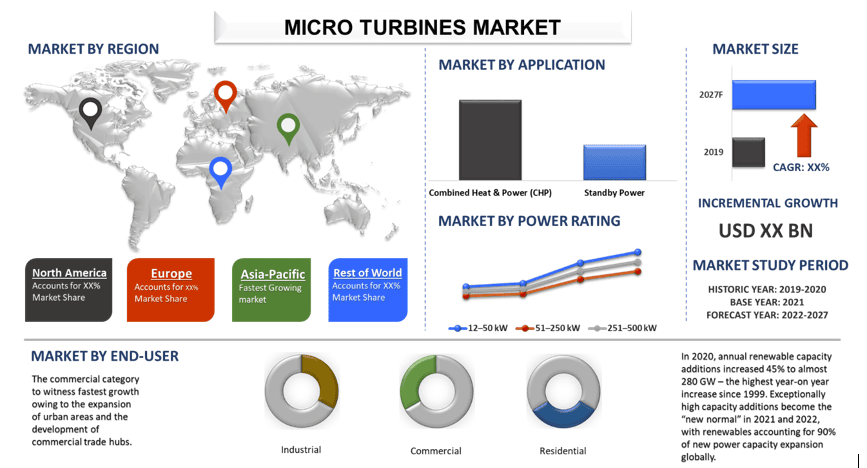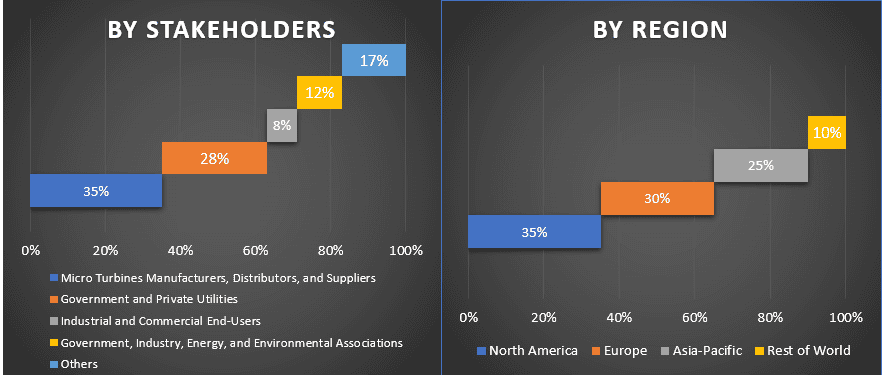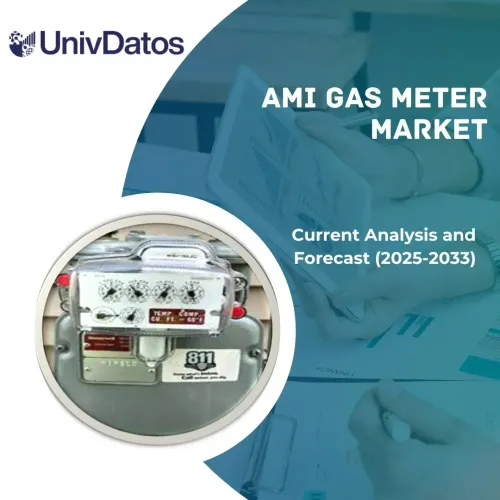- Home
- About Us
- Industry
- Services
- Reading
- Contact Us
Micro Turbines Market: Current Analysis and Forecast (2021-2027)
Emphasis on Type (HFO-1234yf, HFO-1234ze, HFO-1336mzz, HFO-1233zd, and Others); Application [Refrigerant (Commercial, Industrial, Residentials, Mobile Air-Conditioning Systems (MACs)), Blowing Agents, Propellants, Solvents, and Others]; End-User (HVAC, Automobile, Polymers & Plastics, Aerosol, Industrial, and Others); and Region and Country

Micro Turbines Market is anticipated display a CAGR of around 5% over the forecast period (2021-2027). The Micro Turbines market has captured significant market demand and is expected to grow at an influential rate in the forecasted period as well. It is mainly due to increasing digitization and a rise in the population. Moreover, the government is investing in expanding its existing electricity transmission and distribution systems to cater to the rising electricity demand due to rapid urbanization and industrialization. Furthermore, a rise in average electricity consumption is anticipated to account for steady growth in the Micro Turbines market. In addition, increasing consumption of electricity and a growing emphasis on renewable electricity generation are the key factors driving the market’s growth. For instance, in 2020, annual renewable capacity additions increased 45% to almost 280 GW – the highest year-on year increase since 1999. Exceptionally high capacity additions become the “new normal” in 2021 and 2022, with renewables accounting for 90% of new power capacity expansion globally.
Capstone Green Energy Corporation, FlexEnergy Energy Systems Inc., Toshiba Corporation, Bladon Micro Turbine, Micro Turbine Technology BV (MTT), Calnetix Technologies LLC, Ansaldo Energia S.P.A., NewEnCo., Aurelia Turbines Oy, and Bowman Power Group Ltd. are some of the prominent players operating in the Micro Turbines market. Several M&As along with partnerships have been undertaken by these players to facilitate customers with hi-tech and innovative products/technologies.
Insights Presented in the Report
“Amongst Power Rating, 51–250 kW category to hold significant market share”
Based on power rating, the micro turbine market is bifurcated into three segments: up to 12–50 kW, 51–250 kW, and 251–500 kW. In 2020, the 51–250 kW category accounted for a considerable share of the market. This is mainly due to their higher adoption in across industrial and commercial applications. Moreover, due to growing population, increasing urbanization, and the rise in domestic manufacturing, demand for micro turbines has been on the rise. Additionally, the rising adoption of green buildings due to the increasing awareness pertaining to the health and environment hazards of carbon emission has resulted in fostering the growth of the market worldwide. Micro turbines are used in distributed generation applications due to their flexibility in connection methods, their ability to be stacked in parallel to serve larger loads, their ability to provide stable and reliable power, and their low emissions compared to other technologies.
“Amongst End-User, Commercial category to witness strong CAGR”
On the basis of end-user, the market is categorized into Industrial, Commercial, and Residential. During the forecast period, the commercial category to witness fastest growth owing to the expansion of urban areas and the development of commercial trade hubs coupled with growing focus on using green construction techniques to build energy efficient buildings and reducing construction costs. In addition, construction of green buildings is gaining momentum owing to benefits like less energy consumption and reduced operational and maintenance costs. Governments, especially in developed countries, are offering new policies and initiatives to promote green construction. Furthermore, with rapid rates of urbanization, commercial expansion, and industrial development, emerging countries are creating favorable opportunities for the green building industry. Thus, with rising number of green commercial and industrial buildings, the micro turbine market is also expected to witness significant growth.
“Amongst Application, Combined Heat and Power (CHP) Category to Witness Higher CAGR”
Based on application, the Micro Turbines market has been bifurcated into CHP and Standby Power. The CHP application category is expected to grow at the higher CAGR during the forecast period. This is mainly due to the high adoption and usage of micro turbines in wastewater treatment plants, breweries, rubber mills, paper mills, and others, which require heat to drive various internal processes. Furthermore, in CHP applications, the waste heat from the micro turbine is used to produce hot water, to heat building space, to drive absorption cooling or desiccant dehumidification equipment, and to supply other thermal energy needs in a building or industrial process. Capstone Green Energy Corporation is one of the major player in the market offering micro gas turbine CHP systems with multiple cost, environmental and operational advantages to a broad range of commercial and industrial organizations.
“North America Dominated the Global Micro Turbines Market in 2020”
North America constitutes the largest market for the industry due to higher consumption rates in U.S. construction, mining, wastewater treatment, and pharmaceutical industries. Shale gas developments in the region are also anticipated to significantly contribute to market growth in the near future. Additionally, planned capacity expansions in existing power plants coupled with aging power plants and frequent natural calamities have created enormous growth opportunities for the micro turbine market in this region. Furthermore, major players in the market such as Capstone Green Energy Corporation, FlexEnergy Energy Systems Inc., and Calnetix Technologies LLC have strong presence in North American market. Capstone Green Energy Corporation is one of the largest player in the region offering micro turbine technology solutions for use in stationary distributed power generation and distribution networks applications, including energy efficient CHP, integrated combined heat and power (ICHP), and combined cooling, heat and power (CCHP), as well as renewable energy, natural resources, and critical power supply applications. Thus, growing presence of major players in the region to drive the market growth.
Reasons to buy this report:
- The study includes market sizing and forecasting analysis validated by authenticated key industry experts
- The report presents a quick review of overall industry performance at one glance
- The report covers an in-depth analysis of prominent industry peers with a primary focus on key business financials, product portfolio, expansion strategies, and recent developments
- Detailed examination of drivers, restraints, key trends, and opportunities prevailing in the industry
- The study comprehensively covers the market across different segments
- Deep dive regional level analysis of the industry
Customization Options:
Micro Turbines market can further be customized as per the requirement or any other market segment. Besides this, UMI understands that you may have your own business needs, hence feel free to connect with us to get a report that completely suits your requirements.
Table of Content
Analyzing the historical market, estimation of the current market, and forecasting the future market of the Micro Turbines market were the three major steps undertaken to create and analyze the adoption of Micro Turbines in major regions globally. Exhaustive secondary research was conducted to collect the historical market numbers and estimate the current market size. Secondly, to validate these insights, numerous findings and assumptions were taken into consideration. Moreover, exhaustive primary interviews were also conducted, with industry experts across the value chain of the Micro Turbines market. Post assumption and validation of market numbers through primary interviews, we employed a top-down/bottom-up approach to forecasting the complete market size. Thereafter, market breakdown and data triangulation methods were adopted to estimate and analyze the market size of segments and sub-segments the industry pertains to. Detailed methodology is explained below:
Seek More Details About Research Methodology
Analysis of Historical Market Size
Step 1: In-Depth Study of Secondary Sources:
Detail secondary study was conducted to obtain the historical market size of the Micro Turbines through company internal sources such as annual report & financial statements, performance presentations, press releases, etc., and external sources including journals, news & articles, government publications, competitor publications, sector reports, third-party database, and other credible publications.
Step 2: Market Segmentation:
After obtaining the historical market size of the Micro Turbines market, we conducted a detailed secondary analysis to gather historical market insights and share for different segments & sub-segments for major regions. Major segments included in the report as Power Rating, Application, and End-User. Further country-level analyses were conducted to evaluate the overall adoption of Micro Turbines in that region.
Step 3: Factor Analysis:
After acquiring the historical market size of different segments and sub-segments, we conducted a detailed factor analysis to estimate the current market size of Micro Turbines. Further, we conducted factor analysis using dependent and independent variables such as increasing digitalization of industries and urbanization in developing countries. A thorough analysis was conducted for demand and supply-side scenarios considering top partnerships, merger and acquisition, business expansion, and product launches in the Micro Turbines sector across the globe.
Current Market Size Estimate & Forecast
Current Market Sizing: Based on actionable insights from the above 3 steps, we arrived at the current market size, key players in the Micro Turbines market, and market shares of the segments. All the required percentage shares split, and market breakdowns were determined using the above-mentioned secondary approach and were verified through primary interviews.
Estimation & Forecasting: For market estimation and forecast, weights were assigned to different factors including drivers & trends, restraints, and opportunities available for the stakeholders. After analyzing these factors, relevant forecasting techniques i.e., top-down/bottom-up approach was applied to arrive at the market forecast about 2027 for different segments and subsegments across the major markets globally. The research methodology adopted to estimate the market size encompasses:
- The industry’s market size, in terms of value (US$) and the adoption rate of Micro Turbines across the major markets domestically
- All percentage shares, splits, and breakdowns of market segments and sub-segments
- Key players in the Micro Turbines market in terms of products offered. Also, the growth strategies adopted by these players to compete in the fast-growing market
Market Size and Share Validation
Primary Research: In-depth interviews were conducted with the Key Opinion Leaders (KOLs) including Top Level Executives (CXO/VPs, Sales Head, Marketing Head, Operational Head, and Regional Head, Country Head, etc.) across major regions. Primary research findings were then summarized, and statistical analysis was performed to prove the stated hypothesis. Inputs from primary research were consolidated with secondary findings, hence turning information into actionable insights.
Split of Primary Participants in Different Regions

Market Engineering
Data triangulation technique was employed to complete the overall market estimation and to arrive at precise statistical numbers of each segment and sub-segment of the Micro Turbines market. Data was split into several segments & sub-segments post studying various parameters and trends in the areas of type and their type of the Micro Turbines market.
The main objective of the Micro Turbines Market Study
The current & future market trends of Micro Turbines were pinpointed in the study. Investors can gain strategic insights to base their discretion for investments from the qualitative and quantitative analysis performed in the study. Current and future market trends were determined the overall attractiveness of the market at a regional level, providing a platform for the industrial participant to exploit the untapped market to benefit as a first-mover advantage. Other quantitative goals of the studies include:
- Analyze the current and forecast market size of Micro Turbines in terms of value (US$). Also, analyze the current and forecast market size of different segments and sub-segments
- Segments in the study include areas of power rating, end-users, and applications
- Define and analysis of the regulatory framework for the Micro Turbines industry
- Analyze the value chain involved with the presence of various intermediaries, along with analyzing customer and competitor behaviors of the industry
- Analyze the current and forecast market size of the Micro Turbines market for the major region
- Major regions studied in the report include North America (the U.S, Canada, and Rest of North America), Europe (Germany, United Kingdom, France, Spain, Italy, and Rest of Europe), Asia-Pacific (China, Japan, India, Australia, and Others), and the Rest of the World
- Company profiles of the Micro Turbines market and the growth strategies adopted by the market players to sustain in the fast-growing market
Deep dive regional level analysis of the industry
Related Reports
Customers who bought this item also bought










